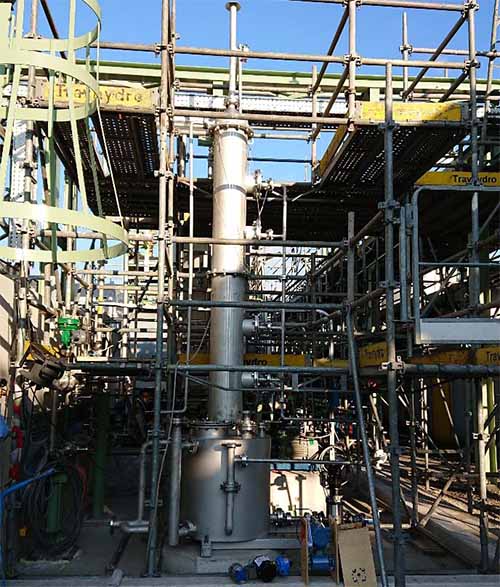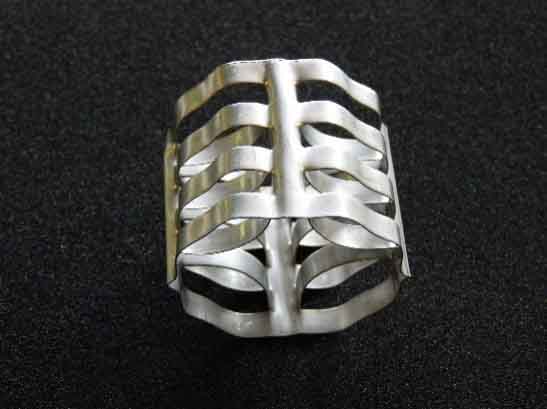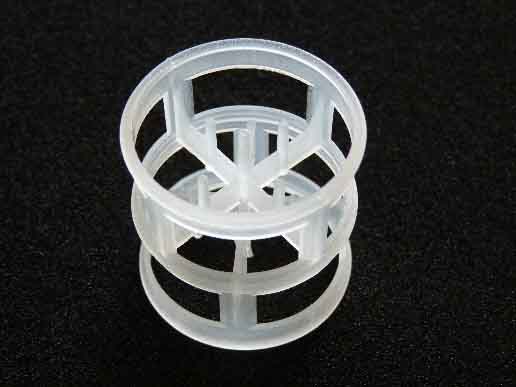Packed scrubber columns
Packings is a collective term for a contact body that can be used in a wet gas scrubber to improve the process of mass transfer in the gas stream with the counter current washing liquid. Packings can be structured which means that it consists of a package of segmented parts that are stacked in the column. A common variant of a packing are the random types which consist of specifically shaped components which fill the column over a predetermined height.

 A packed scrubber column consists of a vertical cylindrical housing including internals such as droplet separators, liquid distributors, packing, a carrier grille and can contain a cover grid. The internals used and the combination of the internals depends on the application and will therefore be different for practically every application.
A packed scrubber column consists of a vertical cylindrical housing including internals such as droplet separators, liquid distributors, packing, a carrier grille and can contain a cover grid. The internals used and the combination of the internals depends on the application and will therefore be different for practically every application.
Packing materials provide a large contact area, creating the maximum achievable mass transfer. They are available in a variety of forms, each with specific characteristics like specific surface area, pressure drop, weight, corrosion resistance and cost. The service life of the packings depends on the application. In ideal conditions, the packings will last if the column itself. In adverse conditions, the packings can sometimes become unusable much faster due to corrosion, contamination, collapse, and breakage. Packings are categorized as random or structured. Random packings are usually dumped in an absorption column and allowed to settle. Modern random packings consist of shapes designed in such a way that the ratio between surface and volume is maximized and the pressure drop is minimized.
Chemical components

 Not only the process has a major influence on the type of packings that is used, but also the (chemical) components, that are carried by the gas, have an influence. For example, when highly corrosive particles, solvents or gases are used, the use of corrosion-resistant alloys or plastic materials for column internals is inevitable.
Not only the process has a major influence on the type of packings that is used, but also the (chemical) components, that are carried by the gas, have an influence. For example, when highly corrosive particles, solvents or gases are used, the use of corrosion-resistant alloys or plastic materials for column internals is inevitable.
The column itself can be made of (stainless) steel or plastic, or a combination of these materials, depending on the corrosivity of the gas, the composition of the washing liquid, operating pressure, and temperature. An alloy that is chemically and temperature-resistant or multiple layers of different, less expensive materials can then be used. For example, the housing can be coated with a protective coating or inner jacket, often made of a corrosion-resistant polymer. For absorption with acid gases, an inner layer of acid-resistant stones, a coating with fluoroplastics or (glass) enamel can provide an extra chemical resistance.

A liquid distributor is designed to flush the packings evenly and to initiate a uniform contact between the liquid and the gas. The liquid distributor must distribute the liquid evenly, non-clogging and contamination, provide a large free volume for the gas flow and allow operational flexibility. The tall columns often have a liquid redistribution to collect liquid from the column wall and distribute it back to the center of the column which  leads to contact improvement in the underlying section of the packings. Fluid redistributors are generally required for every 2,500 to 6,000 mm packing height; this is of course in relation to the diameter of the column. The fluid distributors fall into two categories: gravity types, distribution plates, and pressure types, such as spray systems and perforated pipes. Nozzles are the most common distributors, but they can generate a fine mist that can easily be carried away in the gas stream. They can also clog, and usually require large flows to compensate for poor distribution. Liquid distributors usually consist of flat trays with several gutters for gas flow and perforations in the tray floor for liquid flow. The trays themselves can cause a sometimes-unwanted pressure loss in the gas flow.
leads to contact improvement in the underlying section of the packings. Fluid redistributors are generally required for every 2,500 to 6,000 mm packing height; this is of course in relation to the diameter of the column. The fluid distributors fall into two categories: gravity types, distribution plates, and pressure types, such as spray systems and perforated pipes. Nozzles are the most common distributors, but they can generate a fine mist that can easily be carried away in the gas stream. They can also clog, and usually require large flows to compensate for poor distribution. Liquid distributors usually consist of flat trays with several gutters for gas flow and perforations in the tray floor for liquid flow. The trays themselves can cause a sometimes-unwanted pressure loss in the gas flow.
Packings specially designed for absorption towers


 The first random packings specially designed for absorption towers were made of ceramics. The use of ceramics has decreased due to their vulnerability, relatively unfavorable volume-to-surface ratio, and cost price, so that the current market is dominated by metal and plastic. Metal packings generally cannot be used for highly corrosive substances, such as acid gas, and plastic packings are not suitable for high temperature applications.
The first random packings specially designed for absorption towers were made of ceramics. The use of ceramics has decreased due to their vulnerability, relatively unfavorable volume-to-surface ratio, and cost price, so that the current market is dominated by metal and plastic. Metal packings generally cannot be used for highly corrosive substances, such as acid gas, and plastic packings are not suitable for high temperature applications.

The most common packed columns are of a countercurrent principle. If the waste gas flows upwards in the packed column, resistance will be built up because of the packings and the counter current washing liquid. The pressure drop in a column is the function of the gas flow and liquid flow and the characteristics of the packings such as the specific surface area and the free volume. A high pressure drop results in a high fan power to push the gas through the packed column and will, therefore, incur high costs.
For each column, there are upper and lower limits to the washing liquid and gas flows to ensure good performance. The gas flow rate can become for instance excessively that the resistance to the washing liquid becomes so high that the washing liquid can no longer flow freely through the column. The washing liquid begins to accumulate and blocks the entire surface for the gas, increasing the pressure drop and preventing the washing liquid and gas in the gas from mixing effectively. When all free volume in the packings is filled with washing liquid and the liquid is pushed upwards in the column, the scrubber is considered flooded. Most packed columns operate at 60 to 70 percent of the flood rate of gas, because it is not practical to operate a column in flooded circumstances. A minimum liquid flow rate is also required to irrigate the packings sufficiently to allow an effective mass transfer between the gas and the washing liquid to take place.
Inlet temperature of the waste gas
The inlet temperature of the waste gas in a wet gas scrubber is another important parameter. In general, the higher the gas temperature, the lower the absorption rate and vice versa. Excessively high gas temperatures can also lead to a significant loss of washing liquid due to evaporation. For this reason, gas coolers (e.g., quenchers) are necessary to reduce the gas temperature to acceptable levels.
For processes based on chemical reaction with absorption, an additional concern is the reaction rate between washing liquid and the pollutant(s). Most chemical gas absorption reactions are relatively fast, and the limit is often the physical absorption of the pollutants in washing liquid. However, for solvent-polluting systems where the chemical reaction is the limiting step, the reaction rates must be analyzed kinetically. As a result, it may be necessary to use an extra-large buffer tank for the chemical reaction to take place further. Heat can arise because of exothermic chemical reactions. Heat can also be generated when large amounts are absorbed into the washing liquid, due to the heat of the solution. The resulting temperature change along the height of the absorber column can damage the internals or instrumentation and reduce absorption efficiency.
For example, this problem can be prevented by applying external heat exchangers or cooling coils in the column. However, in those systems where the washing liquid is plain water, adiabatic cooling of the gas occurs during absorption due to evaporation. This causes a significant cooling of the column whereby the heat generated by chemical reactions is often fully compensated. Cooling coils are therefore rarely required in this type of process. In any case, packed columns may be designed as isothermal processes which prevail throughout the column. The effluent from the column can be recycled in the system and reused. This is usually the case if the solvent is expensive or should not hardly be discharged. Initially, the discharge or recycling flow is pumped to a wastewater treatment plant to remove the pollutants or reaction product. Fresh washing liquid can then be supplemented before the washing liquid flows back into the column. Recirculation of washing liquid obviously requires a pump, recovery system of the washing liquid, dosing systems for additives and all associated pipes, appendages, and instrumentation.
Design of packed scrubber columns
The design of packed scrubber columns for cleaning gas streams containing a mixture of pollutants or components in gas depends on the following parameters:
- The flow rate of the waste gas;
- Composition of the waste gas and the concentration of pollutants and components;
- Required removal efficiency;
- Equilibrium relationship between the pollutants, components, and the washing liquid;
- Properties of the pollutant(s), components and the gas and washing liquid:
- Diffusivity;
- Viscosity;
- Specific gravity;
- Molecular weight
Primary objectives
The primary objectives of the design procedures are to determine the column area and the pressure loss over the column. To determine these parameters, the following steps must be determined:
- Gash and fluid flow conditions entering and leaving the column;
- Absorption factor;
- Diameter of the column;
- Height the column and the approach surface;
- Pressure drop over the entire column.
Design of the scrubber
Scrubbers are designed based on the ratio of liquid to gas entering the column, slope of the equilibrium curve, and the desired removal efficiency. These factors are calculated based on the variable inlet and exhaust gas and the washing fluid flow rate:
- Waste gas flow rate, in operating cubic meters per hour at the entrance and exit of the column;
- Concentration of pollutants in the waste gas (contamination in moles per mole of clean gas) at the entrance and exit of the column;
- Washing liquid flow rate, in cubic meters per hour at the entrance and exit of the column;
- Pollutant concentration in washing liquid (in moles contaminate per mole of clean washing liquid).
Droplet separators

 At high(er) gas velocities, the gas leaving the top of the column can carry liquid droplets with it, this is called entrainment. To prevent this, a droplet separator in the form of a chevron type or a wire mesh demister can be installed at the top of the column to collect the droplets, agglomerate them, and drop them back into the column.
At high(er) gas velocities, the gas leaving the top of the column can carry liquid droplets with it, this is called entrainment. To prevent this, a droplet separator in the form of a chevron type or a wire mesh demister can be installed at the top of the column to collect the droplets, agglomerate them, and drop them back into the column.